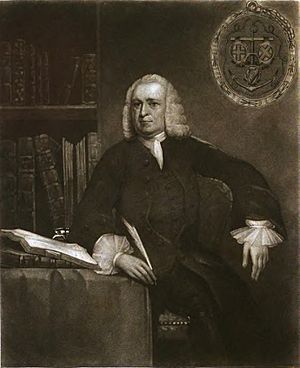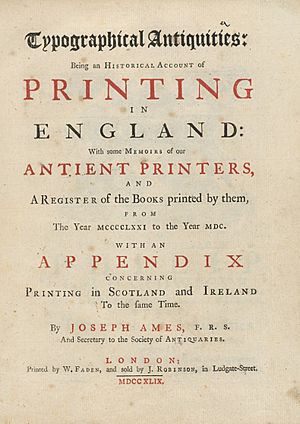Joseph Ames (author) facts for kids
Quick facts for kids
Joseph Ames
|
|
|---|---|

Gravura de Joseph Ames em Typographical antiquities; or the history of printing in England, Scotland and Ireland, 1810
|
|
| Born | 23 January 1689 |
| Died | 7 October 1759 (aged 70) |
| Occupation | Bibliographer, antiquarian, merchant |
Joseph Ames (born January 23, 1689 – died October 7, 1759) was an English expert on old books and a collector of ancient things. He is best known for writing a book called Typographical Antiquities (published in 1749). This book was about the history of printing in England from 1471 to 1600.
It's not fully clear what his main job was. He might have been a merchant who supplied ships, or someone who made tools. Even though he only went to grammar school, he became successful in business. He collected many valuable old books and historical items.
Contents
Ames's Life Story
Joseph Ames was born in Yarmouth, England, on January 23, 1689. He was the oldest child of John Ames, who worked on merchant ships.
Joseph went to a small grammar school in Wapping. When he was 12, his father passed away. Three years later, he started an apprenticeship to learn how to make tools.
He later moved back to Wapping and started his own successful business. In 1714, Joseph married Mary Wrayford. They had six children, but sadly, only one daughter survived. Mary passed away in 1734.
Joining Important Societies
In 1736, Ames was chosen to be a member of the Society of Antiquaries. This group studies ancient history and artifacts. Five years later, he became the secretary for the society and held this job until he died.
He also became a member of the Royal Society in 1743. This is a very old and respected group for scientists. Joseph Ames passed away on October 7, 1759, at the age of 70. He was buried in the churchyard of St George-in-the-East.
What People Thought of Ames
Joseph Ames wasn't really a professional writer. Some people didn't always agree with him, especially in the Society of Antiquaries.
One person, Edward Rowe Mores, called him "an arrant blunderer." He even accused Ames of tearing out the title pages from rare books in his collection.
Another person, Francis Grose, suggested that the history of printing published under Ames's name was actually written by someone else, John Ward. However, Ames likely collected all the information for it.
Despite some criticism, others like William Oldys praised Ames. Oldys called him "a worthy preserver of antiquities," meaning he was good at saving old and important items.
A Passion for Collecting
Joseph Ames loved to collect things. He gathered a large number of portraits, especially those of printers. He also collected coins, interesting natural items, old writings, and rare English books and manuscripts.
Many of his books had notes written by their previous owners. His collection also included valuable historical documents. After he died in 1760, his collection was sold.
Among his collection was a special copy of his book, Typographical Antiquities. This copy had extra blank pages with handwritten notes and additions. This special book was later used by William Herbert to create his own updated version of the book. Another edition was made by Thomas Frognall Dibdin.
Ames's Published Works
Joseph Ames published several important works during his lifetime:
- A Catalogue of English Printers (1739–40): This was a short list of English printers from 1471 to 1600. He asked other people to send him more information to help him with his bigger project.
- An Index to the Pembrokian Coins and Medals (around 1746): This was an index for a book of engravings of old coins.
- A Catalogue of English Heads (1748): This book described about 2,000 prints of English people. It was the first attempt to describe English engraved portraits in detail.
- Typographical Antiquities (1749): This was his most famous work. It was a large book about the history of printing in England. It also included information about printers and the books they printed from 1471 to 1600. He also added a section on printing in Scotland and Ireland.
- Parentalia (1750): This book was a memoir about the Wren family, especially Sir Christopher Wren, a famous architect. Ames worked on this book with Sir Christopher Wren's grandson.
Ames was inspired to study old books by his friends, including John Lewis, who had already started collecting information for a history of printing. Lewis suggested that Ames should take on the project.
Ames was very careful in his research. He didn't just use existing lists. Instead, he looked at the actual title pages of the old books themselves. This helped future experts who studied old books.
Images for kids
-
Frontispiece to Typographical antiquities (1749), showing many printers' rebuses.



